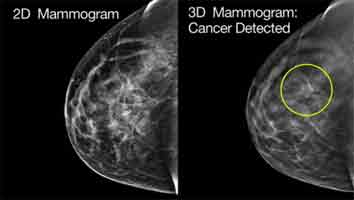3D breast screens improve detection and reduce false positives
 Three-dimensional (3D) breast screens (mammograms) could offer substantial improvements in cancer detection and reducing false positives when used in conjunction with traditional two-dimensional (2D) mammograms, according to the results of a new study published in The Lancet Oncology.
Three-dimensional (3D) breast screens (mammograms) could offer substantial improvements in cancer detection and reducing false positives when used in conjunction with traditional two-dimensional (2D) mammograms, according to the results of a new study published in The Lancet Oncology.
A team of Italian and Australian researchers, represented by Associate Professor Nehmat Houssami, at the University of Sydney’s School of Public Health in Australia, examined whether combined 2D and 3D screening was better at detecting cancers and reducing false positives than 2D screening alone. 7292 women, with an average age of 58, were screened in Trento and Verona, Italy: their screens were firstly reported using 2D mammograms, and then using 2D and 3D mammograms combined.
The researchers detected 59 cancers in total, in 57 patients. Around two-thirds of the cancers detected (39, 66%) were found in both 2D and integrated 2D and 3D screening, but a third (20, 33%) of cancers were not spotted when just the 2D screen was used, and only came to light when integrated 2D and 3D screening was used. This is equivalent to a rate of 5.3 cancers per 1000 screens detected by 2D screening alone, compared to 8.1 cancers per 1000 screens detected by integrated 2D and 3D screening.
3D mammography has previously been explored in a few relatively small studies, but the new study is the first completed trial to report on the effectiveness of 3D screening in a large group of women attending population-based screening. The researchers also found that the integrated 2D and 3D screens resulted in fewer false positives (where screening indicates that there is a suspicious abnormality, which turns out to be a false alarm after further testing).
From all the false positive screens which occurred in the trial, 141 false positives occurred at 2D screening only, compared with 73 at integrated 2D and 3D screening, although 181 false positives occurred at both screen readings, indicating that this is still an important issue that needs to be accounted for in breast screening.
According to Professor Houssami, “Although controversial, mammography screening is the only population-level early detection strategy that has been shown to reduce breast cancer mortality in randomised trials. Irrespective of which side of the mammography screening debate one supports, efforts should be made to investigate methods that enhance the quality of, and hence potential benefit from, mammography screening.”*
Professor Houssami adds that, “We have shown that integrated 2D and 3D mammography in population breast-cancer screening increases detection of breast cancer and can reduce false-positive recalls depending on the recall strategy. Our results do not warrant an immediate change to breast-screening practice, instead, they show the urgent need for randomised controlled trials of integrated 2D and 3D versus 2D mammography.”


